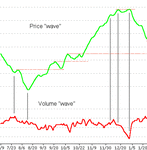Splitlink said:
I've been through these posts more than once and have come to the reluctant conclusion that I am incapable of reading anything meaningful into volume figures .
. . .it is unlikely to be either better or worse than any mechanical method which has been reasonably backtested and is coupled with self-discipline.
Not everyone is. And if one trades something that doesn't provide "volume figures", as you call them, then he will have even more difficulty assigning meaning to something that doesn't seem to be there.
Volume "figures" are, of course, largely irrelevant to the task. As are volume bars. What does matter is trading activity, which is what volume "figures" and volume graphics are supposed to illustrate. But few people are able to get there because they attempt to learn how to incorporate the dynamics of trading activity into their trading by reading message board posts rather than by watching price and "volume" move in real time. One can post illustrative examples, as I and others have done, but regardless of whether they are examples of what happened several years ago or five minutes ago, they are by their nature hindsight. The only way to surmount this obstacle is by tracking these movements with somebody in real time in some sort of chat room or by IM or whatever.
And as for the testing, yes, of course. Only through observation and testing can one determine the truth, as opposed to hanging on some guru's every word or on what one read in a book somewhere. I'm sure you've read, for example, that one should "never short a dull market", but I've found no truth in this at all. You've probably also heard or read that one shouldn't trade at all if volume/trading activity drops below some threshold or other, but I haven't found any truth in this either.
Unfortunately, 95% of the people I've "worked" with are unwilling to do the work. And without the work, it all just lies there. But only through testing can one determine whether or not something works and why and why not. For example, there are various opposing camps with regard to the so-called "Ross Hook", which is essentially a variation on the Dunnigan One-Way Formula and nothing particularly original (though nothing during the past few decades has been particularly original), as well as Bollinger Bands, Fibonacci, "pivot points", MAs, trendlines, etc. All of these features "work" sometimes and "don't work" other times. If, however, one were to incorporate a knowledge and understanding of support and resistance into these efforts, as well as the dynamics of trading activity, he'd very likely learn much that was valuable regarding when all of this is likely to "work" and when it is not likely to do so.
Note also that one need not receive a "volume" feed in order to incorporate trading activity (which, again, is all that volume is) into his tactics. One can determine by watching price movement alone whether trading activity is lackadaisical or fevered. This can't be done in a hindsight chart, of course, but it is obvious in real time. And the point of locating potential levels or zones of S/R in advance is to enable the trader to anticipate that activity (as with the charts I posted in early May).
None of which is to say that you must understand all this in order to trade well. But you might also be misinterpreting the purpose of the work and, therefore, not seeing what is there.
Or maybe not.
--Db


